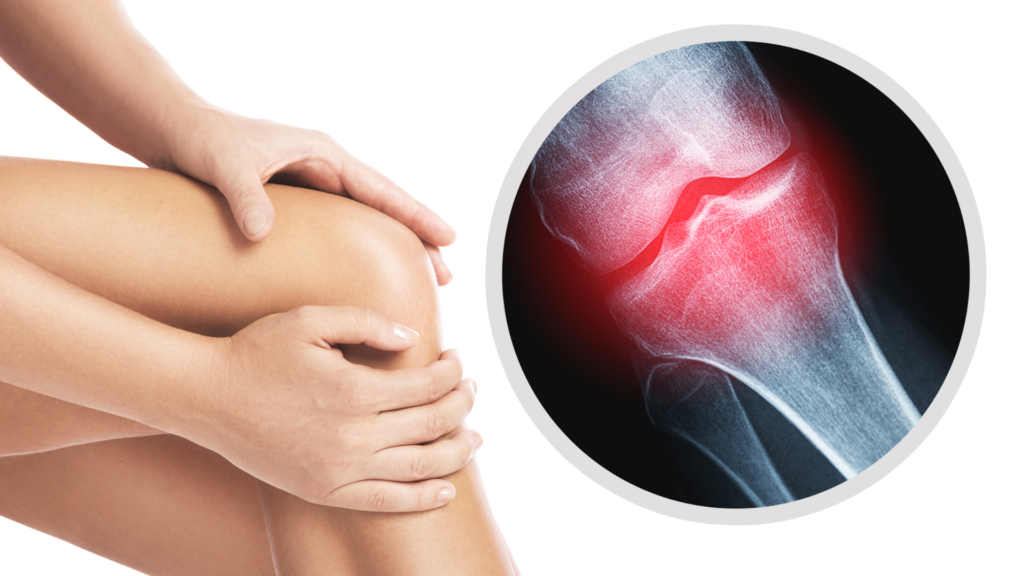Osteoarthritis
Osteoarthritis (OA) is now considered as a complex multifactorial joint pathology caused by inflammatory and metabolic factors underlying joint damage.
The most common treatments of pain in osteoarthritis are:
- exercise-based therapy in combination with pain education (and weight loss if needed),
- nonsteroidal anti-inflammatory drugs (NSAIDs), and
- arthroplasty (joint replacement) surgery.
Patients with osteoarthritis gain approx. 25%-36% pain reduction from long-term treatments of exercise-based therapy in combination with pain education and NSAIDs. It is important we recognise that 10-20% of patients still experience chronic postoperative pain following arthroplasty surgery.
There exists a disconnect between radiographic findings (what you see on your scan/X-Ray) and patient symptoms (pain and stiffness) in osteoarthritis.
Why does your scan or structure of your osteoarthritic joint not tell us the full picture?
It is because structural changes within the body can be normal and not pathological, akin to gray hairs or skin wrinkles. So rather than structure change, your joint are sensitised due to inflammation, in particular synovitis, which has been discussed as a potential reason for the disconnect in a scan vs symptoms experienced.
As seen below, a synovitis is an irritation or inflammation of the joint which helps explain symptoms associated with OA.
Lifestyle Influences
Obesity is prevalent in patients with osteoarthritis. Adipose tissue behaves as an organ which can secrete inflammatory cells, which may elevate your pain. Similarly, obesity is linked with a higher risk of type 2 diabetes, which again is linked to increased systematic inflammation, synovitis, and higher pain levels.
Poor sleep duration and quality is prevalent among patients with chronic pain, including patients with osteoarthritis, sleep is associated with higher levels of depression, anxiety, and pain catastrophizing, which are all factors associated with increased pain sensitivity. For this reason, education about OA is an important inclusion in any exercise program.
The role of biological and environmental factors such as exercise, age, and diet, have been the subject of recent studies for their roles in osteoarthritis inflammation. A good diet and frequent exercise are modifiable factors and highly recommended. Age however, is obviously non modifiable!
Load Management – Understanding your own pain
Everyone has a completely independent experience with their osteoarthritis pain as everyone has a different set of contributing factors. This means as physiotherapists, we have to individually titrate your loading volume, intensity and frequency throughout the week adjusting to your bodies physiology. This is so we do not flare the condition but don’t underload your joints, contributing to deconditioning.
General Physical activity such as walking, cycling or swimming is recommended for general health.
Treatment
Nonpharmacological (non-medication), nonsurgical core treatments for all individuals with knee OA include:
- land-based exercise
- weight management
- strength training (through physiotherapy)
- water-based exercise
- self-management and education.
If you have a highly irritable joint with higher knee loading activities we are able to share load at higher percentages into other joints. An example of this would be including a hinge strategy into your exercise program, temporarily reducing the demands on the knee joint. Any hip dominant/hinge exercise can be used such as: deadlifts and split stance deadlifts to promote lower limb loading throughout the hip.
So with exercise in mind. Our physiotherapists can tailor a strength training program to suit your needs and goals making consideration to your weekly NET load (fig 3). We can improve your joint’s ability to tolerate load by strengthening muscles around the joint. We also know that other tissues including the joint tissues have the ability to positively adapt to the stimulus of resistance training over time such as: bones and ligaments! This is an improvement in your capacity (fig 3). Within this process, your physiotherapist will help upskill your knowledge about your OA and importantly improve your confidence in managing your OA.
Some examples of progressive strength training exercises are:
Step Ups
Lunges
Leg Extensions
Hip Thrusts
Deadlift or Hinge
Take Charge of Your Osteoarthritis Today!
Gaining a clear understanding of osteoarthritis is crucial for effective management and improved quality of life. Discover personalized exercise routines, lifestyle adjustments, and actionable strategies to manage pain and enhance overall well-being with Move Physiotherapy and Fitness. Head to our Book online page now to schedule a consultation. Let us assist you on your journey towards better joint health and greater confidence in managing your condition!

